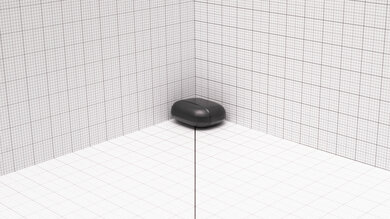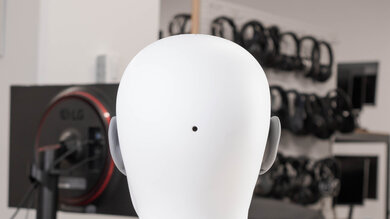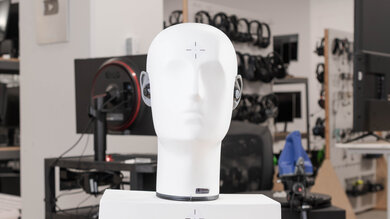The JBL Tune 125TWS Truly Wireless are simple, truly wireless headphones. They have a well-balanced sound profile, decent passive noise isolation capability, and a compact, lightweight design that makes them easy to carry around. Unfortunately, they lack any sound customization features and have a very limited control scheme, not to mention high wireless latency with PCs as well as Android and iOS devices. Still, if you're looking for a pair of truly wireless headphones that you can use to listen to most types of audio content, they're a good option.
Our Verdict
The JBL Tune 125 TWS are satisfactory for neutral sound. They have a well-balanced sound profile with just a touch of extra bass, which should give EDM and hip-hop tracks a bit of extra thump and rumble without overwhelming delicate vocals or instrumentals. Unfortunately, they have a very closed-off passive soundstage and don't have a companion app with an EQ to fine-tune your listening experience.
- Well-balanced sound profile.
- Remarkably consistent audio delivery.
- Closed-off soundstage.
- No sound customization features.
The JBL Tune 125 TWS are decent for commuting and traveling. They're lightweight and easy to carry around and feel reasonably well-made. While they may not block out the low rumble of bus or plane engines, you shouldn't hear much chatter from other commuters. Unfortunately, their control scheme doesn't support on-the-fly volume adjustments, and their deep in-ear fit may not suit all listeners.
- Well-balanced sound profile.
- Compact, lightweight design.
- Decent passive noise isolation.
- No on-board volume controls.
- No standby mode to extend battery life.
The JBL Tune 125 are a very good option for sports and fitness. They're very lightweight and easy to carry around. While they should stay in place during light workouts, they're liable to fall out during intense exercise sessions due to their lack of stability fins. They also don't have any IP rating for dust or water resistance.
- Well-balanced sound profile.
- Compact, lightweight design.
- Remarkably consistent audio delivery.
- No on-board volume controls.
- No IP rating.
The JBL Tune 125 TWS are satisfactory for office use. They should block out the chatter of nearby coworkers and leak very little audio. However, they don't have any sort of standby mode to extend their battery life and lack any multi-device pairing capability. They also have high wireless latency on PCs, which could be an annoyance while watching videos.
- Well-balanced sound profile.
- Decent passive noise isolation.
- Low audio leakage.
- High wireless latency on PCs.
- No standby mode to extend battery life.
- No multi-device pairing capability.
The JBL Tune 125 TWS aren't compatible with Xbox or PlayStation consoles. They work with Bluetooth-enabled PCs as well as iOS and Android devices, but their latency is too high to be suitable for gaming.
The JBL Tune 125 TWS are Bluetooth-only headphones, and you can't use them wired.
The JBL Tune 125TWS are a fair choice for making phone calls. Their integrated microphone makes your voice sound clear but thin, and struggles to separate it from loud background noise. The headphones also lack ANC and don't do a good job of blocking out noises like rumbling engines, so you may have trouble hearing a call you take on the bus.
- Decent passive noise isolation.
- Sub-par microphone noise handling capability.
Changelog
- Updated Dec 15, 2021: Updated review for accuracy and clarity.
- Updated Aug 04, 2021: Converted to Test Bench 1.5.
- Updated Nov 19, 2020: Review published.
- Updated Nov 13, 2020: Early access published.
Check Price
Differences Between Sizes And Variants
The JBL Tune 125 TWS come in four color schemes: 'Black', 'White', 'Blue', and 'Pink'. We tested the 'Black' variant, and you can see its label here. That said, we expect the other color variants to perform similarly.
If someone comes across a different variant of these headphones, let us know in the discussions below so that we can update our review.
Popular Headphones Comparisons
The JBL Tune 125 TWS are basic truly wireless headphones but represent a marked improvement over the similarly-designed JBL Tune 120 Truly Wireless. They have a fairly well-balanced sound profile, decent passive noise isolation capability, and reasonably sturdy construction. Unfortunately, they have a very simple control scheme, and they lack any sort of companion software.
If you're considering alternatives, take a look at our recommendations of the best wireless Bluetooth earbuds, the best true wireless earbuds, and the best cheap wireless earbuds.
The Anker Soundcore Life Dot 2 Truly Wireless are slightly better overall than the JBL Tune 125TWS Truly Wireless. The Anker are better-built, more stable in the ear, block out more ambient noise, and leak less audio. They have a much longer total battery life of almost 100 hours, not to mention a battery-saving standby mode. However, the JBL have an easier-to-use control scheme and a better-balanced sound profile.
The JBL LIVE 300TWS Truly Wireless are better mixed usage headphones than the JBL Tune 125TWS Truly Wireless. The 300TWS have a more comfortable and stable fit, a more comprehensive control scheme, sturdier build quality, and a companion app with a parametric EQ. However, the 125TWS have a longer continuous and total battery life, lower wireless latency, and a slightly more neutral sound profile.
The Sony WF-XB700 Truly Wireless and JBL Tune 125TWS Truly Wireless are closely-matched headphones, and you may prefer one over the other depending on your preferences. The Sony headphones have onboard volume controls, a better build quality, and a longer continuous battery life. On the other hand, the JBL come with a case that can store additional three additional charges, while the Sony's case can only hold one. The JBL also have a more neutral sound profile, which some users may prefer, and a better-integrated microphone.
The JBL Tune 125TWS Truly Wireless are more versatile than the Apple AirPods (2nd generation). The JBL block out far more ambient noise, have an easier-to-use control scheme, deliver a better-balanced listening experience with greater consistency, and last longer on a single charge. However, the Apple are better built, are more comfortable, and charge substantially faster. Thanks to their open-back enclosure, they provide a far more expansive listening experience.
Test Results

The JBL Tune 125 TWS are simple-looking truly wireless headphones. They have a low-profile design that doesn't protrude too far from your ears and a conservative monochrome-color plastic casing accented with the matte finish of their multifunction buttons. That said, you can configure their charging case with a variety of eye-catching color schemes and patterns when you order them directly from JBL's website, but at an added cost.
The JBL Tune 125 TWS have a sub-par control scheme. While the buttons are clicky and easy to use, the control scheme is quite limited and lacks a way to change the volume. There are also no voice prompts or beeps for most commands. You can use either earbud one at a time, but you lose the ability to skip tracks when you do.
On the left earbud:
- Single tap: Skips the track forward.
- Double-tap: Skips the track backward.
On the right earbud:
- Single tap: Plays and pauses audio. Also, answers and ends a call.
- Tap and hold Mutes and unmutes the mic.
These in-ears have a good case. It's compact and made of somewhat sturdy-feeling plastic. Like the JBL Tune 120 Truly Wireless' case, the headphones' controls are engraved inside the case, which can be handy if you forget how to make a certain command. The case also features magnets to keep the buds in place when they're stored.
The JBL Tune 125 TWS have a reasonably well-balanced sound profile. Their slightly overemphasized bass response should add a bit of extra thump and rumble to your favorite EDM and hip-hop tracks, but without overwhelming vocals or lead instruments in other genres. Overall, these headphones should suit a wide variety of musical genres and audio content. Ηowever, they lack sound customization features such as a graphic EQ or presets that you could use to tweak their sound to suit you.
Like most in-ear headphones, the JBL Tune 125 TWS have exceptional frequency response consistency, though there's some variance in the treble range. Once you achieve a proper fit with the included selection of ear tips, audio should be delivered consistently on separate re-seats.
Their bass accuracy is impressive. The response is flat but slightly overemphasized across the range, so mixes have extra thump, rumble, and punch. The high-bass range is more neutral, though, so their sound isn't overly boomy or muddy.
These headphones offer remarkable mid-accuracy. Aside from a minor dip in the mid-mid range that nudges instruments and lead vocals towards the back of the mix, the rest of the frequency spectrum is remarkably flat and well-balanced. This results in clear, present, and full-bodied vocals and lead instruments.
The JBL Tune 125 TWS have impressive treble accuracy. Vocals and lead instruments should be clear and well-articulated, while sibilants and high notes should be reproduced without being piercing or harsh.
The JBL Tune 125 TWS have great peaks and dips performance. There's a small dip in the mid-mid range that nudges vocals and lead instruments toward the back of the mix. This is followed by a bump that extends across the high-mid through low-treble ranges, which could yield a slightly harsh quality to some notes. A dip in the low through mid-treble ranges can veil the finer details of some vocals and lead instruments and make some sibilants sound slightly dull and lispy.
These headphones have superb stereo imaging performance. Their weighted group delay falls mostly beneath the audibility threshold. There's small peak in the bass range, but it shouldn't be audible with regular content, resulting in tight bass and transparent treble. Their L/R drivers are well-matched in regards to amplitude, frequency, and phase response, which ensures the accurate placement of objects like voices and instruments in the stereo image. That said, these results are only valid for our unit, and your experience may vary.
Like most closed-back in-ears, the JBL Tune 125 TWS have a terrible passive soundstage. Βy design, they bypass any outer-ear interaction, resulting in sound that's perceived to be coming from inside your head rather than speakers placed around you. You may want to consider the JBL Tune 225TWS True Wireless if you're looking for truly wireless headphones with a more spacious passive soundstage, in part due to their shallower earbud fit.
The weighted harmonic distortion performance is impressive. Distortion at both moderate and high volumes remains within good limits across the frequency spectrum, which should result in clean and pure audio reproduction.
These are the settings used to test the JBL Tune 125 TWS. Our results are only valid in this configuration.
These in-ears have decent passive noise isolation. They don't do a very good job of reducing bass-range noise like the rumble of plane engines or traffic outside your window. Ηowever, they block out a good amount of higher-pitched noise like conversations and humming A/C units, so they can help reduce distractions at the office.
The JBL Tune 125 TWS leak very little audio. What little sound does escape occurs in the treble range, giving leaking audio a slightly thin quality. Still, you should be able to listen to your music at pretty high volumes with little fear of disrupting people nearby.
The integrated microphone has a decent recording quality. Your voice should sound natural, clear, and mostly free of distortion, but it doesn't sound very full-bodied.
The integrated microphone has sub-par noise handling. With moderate background noise, your voice is understandable, but it can be completely drowned out by loud noises like the sound of a passing train.
The JBL Tune 125 TWS have a sub-par battery performance. While they're advertised to last for eight hours off a single charge, we measured just under seven. Ηowever, battery performance can vary with real-life use, so your experience may vary. Also, fortunately, they come with a case that holds about three extra charges and don't take too long to recharge. They lack a feature to help conserve battery life, such as an auto-off timer, though.
The JBL Tune 125 TWS have okay Bluetooth connectivity. They support Bluetooth 5.0, but not multi-device pairing, which could be annoying if you like to stream music from your phone while remaining connected to your work computer. Unfortunately, they have high latency with PCs, iOS, and Android devices, so you're likely to notice a delay if you use them to stream video or games. That said, some apps and devices compensate for latency, so your experience in the real world can vary.
These headphones are compatible with Bluetooth-enabled PCs but can't connect any other way. Unfortunately, they have high latency, so you may notice audio lag if you use them to watch a movie on your computer.
The JBL Tune 125 TWS come with a charging case that supplies roughly three extra full charges. It doesn't have any inputs other than a USB-C charging port and doesn't support wireless charging.















